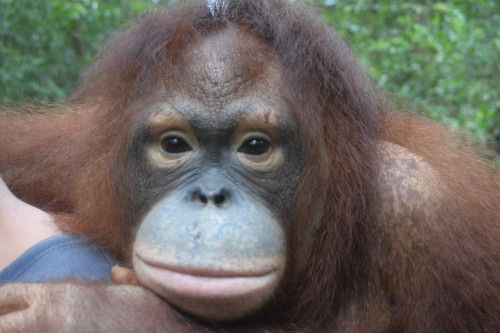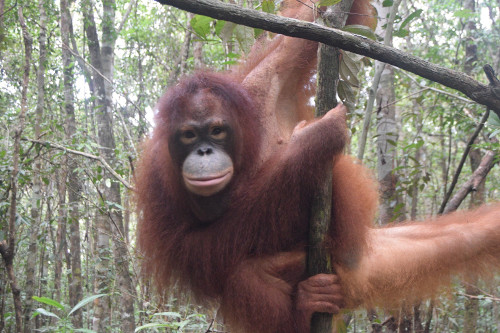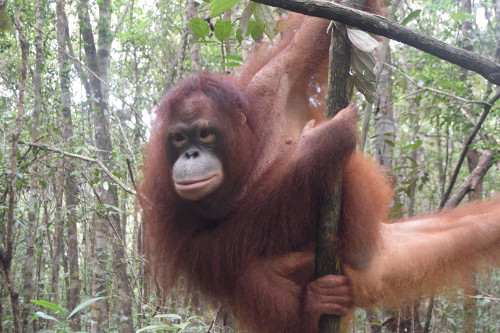Tags:
OOTM Orangutan of the MonthAway deep in the woods, life goes on at Camp Rendell, an adjunct facility to OFI’s Care Center in Central Borneo. An orangutan “soft release” is taking place. The daily soft release process sees the wild born ex-captive orangutans taken out in the morning from their sleeping enclosures and brought back in the late afternoon. Today female orangutan Bama is journeying to the Learning Forest. As she emerges, she looks up to the sky allowing the sunlight to engulf her face and freckle adorned neck.

Years ago, Bama was handed over to OFI from a Palm Oil Plantation. Sadly, this was not a unique case in of itself but there was one unique aspect. The person handing her over to OFI informed us that palm oil workers had killed the mother. This honesty is unusual as the normal line is “the orangutan infant was found abandoned by the mother.” This honesty didn’t make the situation any easier but at least we know for certain what happened to Bama. Before she came to us. In order to obtain an orangutan infant, mothers are probably almost always killed. A mother can never be replaced but we at OFI can try our best.
Bama learned about the world mainly through interaction with her peers. Different combinations of individuals are brought out together to the forest. Immature orangutans are generally lively and curious about the world, Bama particularly so! Bama is normally released alongside fellow females, Lori Belle, Poppy and Safitri. Just like humans not all orangutans get along so the right grouping helps make releases go as smoothly as possible. Not that releases always go to plan! Despite her losses Bama is independent and well-adjusted to her surroundings. She is also unperturbed by whomever she is released with.
At the edge of the treeline Bama slides off her caregiver’s back and takes herself into the forest, picking out which tree she wishes to climb first. She occupies one in the middle of a mini-clearing swinging in all four directions of the compass looking for somewhere to find purchase. She seems to have no sense of spatial awareness as she flies through the trees wrapped up in her own world. Bama likes to climb high and it can be a long wait until she comes back down to the forest floor from the canopy.
Bama perches on one of the bigger trees and rocks hither and tither around it to break off old branches. The branches snap off and fall easily to the ground. Mission accomplished, she still continues her efforts. An appetite for destruction is not just a human trait but at least here it acts as a form of recycling as the Earth reclaims the branches. It’s good fun for Bama as she expends all her pent-up energy after being let out of her sleeping enclosure. Another branch breaks off and she stares at her handiwork. This also serves as a reminder to the ground bound observer of an orangutan’s formidable strength.


During perambulations around the forest, the caregivers lead Bama to a feeding station set up near camp. This raised wooden platform resembles the feeding stations that can be seen at Camp Leakey and the various posts throughout and near Tanjung Puting National Park where ex-captive wild born orangutans are released after rehabilitation. Supplemental feeding stations ease the strain on the forest during low fruiting seasons and support newly released orangutans as they get used to their new areas. OFI does not just release orangutans back to the wild and break all ties with them. The duty of care extends beyond this. Some orangutans utilise the stations more than others. Individuals are sometimes not seen for long periods once they have returned to the wild. This is an indicator that fruit is plentiful in the forest and they don’t need us which is the ideal outcome.
The feeding stations in the Rendell forest serve several purposes, as the orangutans can be brought here on long days and fed. This helps them get used to the idea of supplemental feeding if there isn’t enough wild fruit in the forest after they are released. Bama careens over to the platform and sits on it expectantly. She has already taken note of what the feeding station is for. Bama is a quick study and picks things up in a snap. As there is nothing on the platform yet, Bama checks her caregiver’s pockets for food. Finding nothing Bama casually headbutts her caregiver’s arm and slinks off.
Bama is a searcher and explorer, navigating her way through the tangled forest. She is always on the move which makes the task of photographing her a challenge all of its own. The perfect shot may be set up but Bama won’t sit still long enough and the photo comes out as an orange blur. Once she is done with the world above, she tumbles down to the world below and rolls around in the long grass. Photography becomes a little easier down here.
After two hours of perpetual motion it is time for some rest and contemplation. Bama kicks back and occupies herself stripping leaves and undressing shoots. She lays flat on the grass with her legs akimbo. Bama eschews the dainty ways of fellow orangutans such as Lady Gilbert preferring a more devil may care attitude to life.
Bama proves once again her skills of observation. She grabs a stick and with both legs sprawled out in front of her begins poking the ground around the tree roots, mimicking the assistants who look for hidden ant and termite nests in this fashion to bring back as enrichment for the orangutans at the Care Center. She is like a child on the beach playing with sand and brings to mind the infant orangutans housed at Camp Danielle. This elicits a parental warmth from onlookers and a protective instinct towards her. At these moments Bama resembles a big cute innocent baby! But not one for too much introspection, Bama grows bored of this activity and heads off, on the move again.
Some paths in the forest are easier to navigate then others. There are several pathways in and around Camp Rendell on the ground but Bama has been known to create her own through the brush and bracken. The prickles, thorns, and variety of overhanging plants are brazenly brushed aside by Bama as she wends her way. It’s not so easy for humans. We need machetes to hack our way through the brush which can be a timely process. The caregivers act with haste so they can keep up with Bama as she delves deeper into the forest. She is as fast on the ground as she is in the trees. Now Bama is chasing her friend, orangutan Poppy, through the undergrowth wanting to play. Bama catches up to her but gets more than she bargained for. The bigger Poppy instantly pins Bama down and comes out on top as they wrestle.
The afternoon is getting on and so the group work their way back towards camp. Bama makes pitstops along the way to grab some fruit from the trees. Bama is in no hurry to get back and the staff wait patiently with her until she is ready. Bama had her normal upbringing taken from her. Nevertheless, OFI strives to restore the balance and provide her with a place of security, safety and opportunity. For Bama, Camp Rendell is this place and she has grown into a smart, active, fun loving and curious individual. One day she will be transferred to the great forest and she will be free to choose whether or not she will use the supplemental feeding stations there. OFI will be with her every step of the way until she needs us no more.
But the big question that always vexes us will be: will there be sufficient forest for Bama and her orangutan friends to thrive as they should in the wild.


